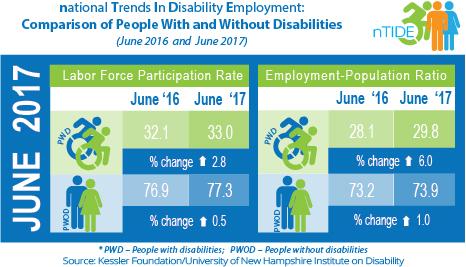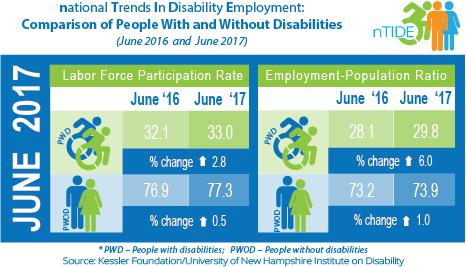
Credit: Kessler Foundation & UNHIOD
East Hanover, NJ -July 7, 2017. Americans with disabilities continued to engage in the labor market, reaching 15 months of job gains, according to today's National Trends in Disability Employment – Monthly Update (nTIDE), issued by Kessler Foundation and the University of New Hampshire's Institute on Disability (UNH-IOD). This extends the longest stretch of recorded gains for this population. As the nation implements the Workforce Innovation and Opportunity Act (WIOA) of 2014, vocational rehabilitation (VR) services are evolving to better serve people with significant disabilities. By aligning VR with programs for students and young adults with severe disabilities, there are more options for their transition to competitive, integrated employment.
In the Bureau of Labor Statistics (BLS) Jobs Report released Friday, July 7, the employment-to-population ratio for working-age people with disabilities increased from 28.1 percent in June 2016 to 29.8 percent in June 2017 (up 6 percent; 1.7 percentage points). For working-age people without disabilities, the employment-to-population ratio also increased from 73.2 percent in June 2016 to 73.9 percent in June 2017 (up 1 percent; 0.7 percentage points). The employment-to-population ratio, a key indicator, reflects the percentage of people who are working relative to the total population (the number of people working divided by the number of people in the total population multiplied by 100).
"Fifteen consecutive months of employment growth for people with disabilities is outstanding news," according to John O'Neill, PhD, director of employment and disability research at Kessler Foundation. "However, there is still a long way to go before people with disabilities reach their pre-Great Recession employment levels, not to mention parity with people without disabilities," he added.
The labor force participation rate for working-age people with disabilities increased from 32.1 percent in June 2016 to 33.0 percent in June 2017 (up 2.8 percent; 0.9 percentage points). For working-age people without disabilities, the labor force participation rate also increased from 76.9 percent in June 2016 to 77.3 percent in June 2017 (up 0.5 percent; 0.4 percentage points). The labor force participation rate is the percentage of the population that is working or actively looking for work.
"The growth in the labor force participation rate of people with disabilities continues to outpace that of people without disabilities, which is a strong indicator that people with disabilities are working, want to work, and are indeed striving to work," said Andrew Houtenville, PhD, associate professor of economics at UNH, and research director at the Institute on Disability.
"Congress has given a clear directive to focus on competitive integrated employment and to positively impact the workforce participation rate of persons with disabilities," states Stephen A. Wooderson, CEO of the Council of State Administrators of Vocational Rehabilitation (CSAVR)."As outlined in WIOA, the priority for public vocational rehabilitation programs is serving job seekers with significant disabilities." With the emphasis on more comprehensive preparation for employment and extended support services in the workplace, connecting with VR is essential for youth and adults who are striving to work. "Incorporating work experiences during high school increases the likelihood of employment after graduation," notes Wooderson, "and options for customized employment and supported employment help meet the needs of jobseekers with significant disabilities."
In June 2017, among workers ages 16-64, the 4,719,000 workers with disabilities represented 3.3 percent of the total 144,945,000 workers in the U.S.
The next nTIDE will be issued on Friday, August 4, 2017.
###
NOTE: The statistics in the nTIDE are based on Bureau of Labor Statistics numbers, but are not identical. They are customized by UNH to combine the statistics for men and women of working age (16 to 64). NTIDE is funded, in part, by grants from the National Institute on Disability, Independent Living and Rehabilitation Research (NIDILRR) (9ORT5022 and 90RT5017) and Kessler Foundation.
About Kessler Foundation
Kessler Foundation, a major nonprofit organization in the field of disability, is a global leader in rehabilitation research that seeks to improve cognition, mobility, and long-term outcomes — including employment — for people with neurological disabilities caused by diseases and injuries of the brain and spinal cord. Kessler Foundation leads the nation in funding innovative programs that expand opportunities for employment for people with disabilities. For more information, visit http://www.KesslerFoundation.org.
About the Institute on Disability at the University of New Hampshire
The Institute on Disability (IOD) at the University of New Hampshire (UNH) was established in 1987 to provide a coherent university-based focus for the improvement of knowledge, policies, and practices related to the lives of persons with disabilities and their families. For information on the NIDILRR-funded Employment Policy and Measurement Rehabilitation Research and Training Center, visit http://www.ResearchonDisability.org.
For more information, or to interview an expert, contact:
Carolann Murphy, 973.324.8382, [email protected]
Laura Viglione, 973.323.3675, [email protected]
Media Contact
Carolann Murphy
[email protected]
973-324-8382
@KesslerFdn
http://www.KesslerFoundation.org
Original Source
https://www.kesslerfoundation.org/content/ntide-june-2017-jobs-report-ongoing-job-growth-reflects-americans-disabilities-striving-work






